Erin M Riley: Navigating the experiences we’re all sharing
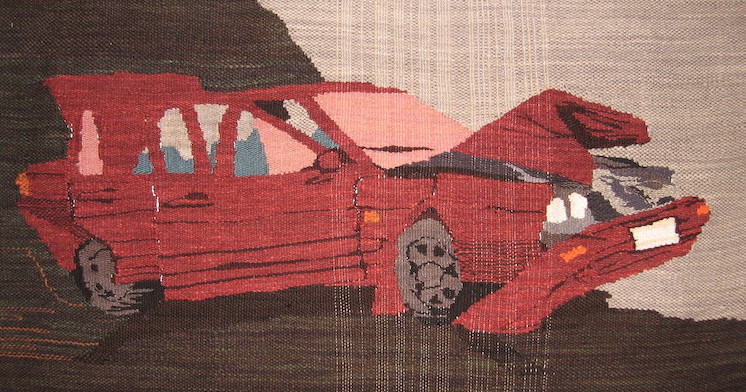
As soon as she learned sewing, Erin Riley became instantly hooked on everything to do with textiles. At art college she soon discovered the loom room and weaving seemed to be the perfect technique to make fine art using a textile technique.
In this interview Erin gives us an insight into how, through her work, she is trying to understand how we are changing with the world around us, or staying the same.
An obsession with perusing craft and fabric stores
TextileArtist.org: What initially captured your imagination about textile art?
Erin M. Riley: I learned sewing in Home Economics class and set the record for threading the sewing machine in my class. It was something I was instantly hooked on, I received the sewing machine I still own for my next birthday. This started my obsession with perusing craft and fabric stores, learning how to embroider, latch hook, and make/modify my own clothes.
I had it in my mind that I would be a fashion designer and set my goals to art school, where I found the fibers department and the loom room at Massachusetts College of Art and Design. It seemed like the perfect fit between painting/fine art and fashion design, which I found to have too much to do with industry, money and trends. I was interested in learning a tangible skill, while allowing the work to have conceptual weight as well; tapestry seemed to be the best way to use imagery and content while using textile techniques.
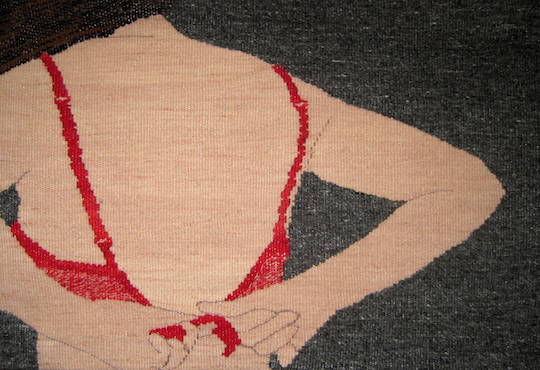
Erin M. Riley: Undressing
What or who were your early influences and how has your life/upbringing influenced your work?
I was a middle child and was a bit of a loner. I didn’t have many friends and had to entertain myself a lot. This meant making, writing, drawing, collaging, reading, and just exploring/thinking. I feel this was my biggest influence, it allowed me to start this obsession with making, but also started my development of communicating with the work I was making.
I have always loved Louise Bourgeois’ work and her personal story that pushed her work forward. My upbringing and family history is deeply embedded into my work; I think about how I became the person I am and which events lead me to have different characteristics.
Making art my life’s priority
What was your route to becoming an artist? (Formal training or another pathway?)
I was fortunate to have extensive art classes in high school, from fine art and ceramics to graphic design. I arranged my schedule so, that by senior year I was almost fully in art classes and was focusing on applying to art school. I ended up going to MassArt where I majored in Fibers. My first year there, I learned to weave, found tapestry and started exploring the woven medium and its history.
I decided to apply for graduate school and continuing straight out of undergraduate to Tyler School of Art. I received my MFA by 2009, I was 23, and was forced to figure out what it meant to be an artist and started applying to residencies around the US. My main goal outside of graduate school was to make making art my life’s priority. I worked jobs that paid the bills, but I always tried to stay part-time so that I could have as much time in the studio as possible.
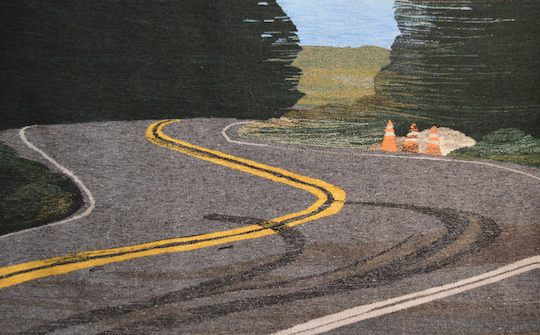
Erin M. Riley: History, 2014
What is your chosen medium and what are your techniques ?
I am a tapestry weaver, I work on a floor loom rather than a vertical warp loom, and all wool I use I hand dye myself. The pieces are woven using a cartoon, which is pinned to the back of the warp as you advance up the tapestry. My work is woven from sourced imagery that I find online, through google searches, Facebook, Instagram and Tumblr. I collect images and compile them in a folder of inspiration, partnered with research and planning for exhibitions, I start a queue and get to weaving.
How would you describe your work and where do you think it fits within the sphere of contemporary art?
For a while I was telling people I was a weaver, first: “Hi, my name is Erin and I am a weaver”, but now I let that come out slowly. I find that, while I am a weaver, I don’t fit the preconceived mould that normal people think of when they hear ‘weaver’.
My work is still finding its niche; it is textile based but it is also fitting into this internet, pop culture genre, while also being aggressive at times, and sad. I don’t know if I have the distance from the work to answer this question properly!
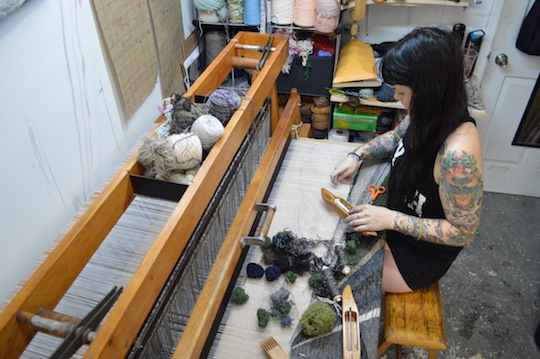
Erin M. Riley at work in her studio
Tell us a bit about your process and what environment you like to work in?
I work every day, depending on what is happening in my life, I am either working on a series of pieces continually for an exhibition or stopping and working on sourcing/creating images to weave. Right now, I have about thirty pieces in queue already planned and drawn out in cartoons for my exhibitions next year. I just moved into a new studio, from which I also live, the room is separate but connected.
My days start out by me waking up, finding coffee, breakfast, and then figuring out where I am in a tapestry. I tend to always leave my work at a good spot the night before, so that it can be picked up easily the next day. I find that if I advance the warp at the end of the day, it’s a good boost to wake up and find the warp in the right spot and ready for the next eight hours.
I also usually wind bobbins the night before; it lets me slide right into work, rather than start the day with the ‘tasks’ of weaving. I weave while listening to podcasts or movies, most of the time music just gets me too sad.
Do you use a sketchbook?
No, but I work from drawings, my ‘downloads’ folder on my computer is a lot like my sketchbook. I have a journal, and I also put notes in my phone.
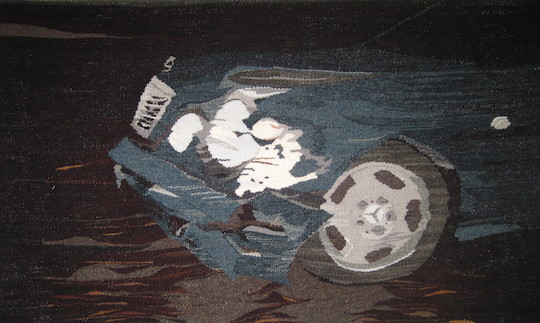
Erin M. Riley: Mercedes, 2011
What it means to be a woman in this world
What currently inspires you and which other artists do you admire and why?
Right now I am really inspired by figuring out what it means to be a woman in this world. I am super into challenging the ideas of sexy, and welcoming other women’s input on my work, and I soon will be trying to invite image submissions. I think what inspires me the most as I grow up is that so many of women’s experiences are similar when it comes to dating, being sexy, and trying to be a productive, respected member of society.
I am also inspired by the things that are happening in the world, in my family and all around me. I am navigating the experiences we are all sharing and trying to understand how we, as humans, are changing with the world around us, or staying the same.
Tell us about a piece of work you have fond memories of and why?
I have always been drawn to the piece ‘Only an Accident‘; it’s a very subtle image, with a bit of blood and a long braid. It is a piece that I feel came across just the way I wanted and it is always interesting to look more at the piece, understanding the different nuances it offers.
How has your work developed since you began and how do you see it evolving in the future?
My work has changed a lot since I began. Initially the limitations were due to the fact that I was still in the early stages of learning tapestry and I was very much inside myself. My work was very literally about my family and the struggles that we were facing at the time.
As I moved away from my home state, I was able to have time to clear my head and start understanding myself, without the narrative of family. This allowed me to spend time on new imagery that was about the underlying issues I felt people in my family faced.
What advice would you give to an aspiring textile artist?
I would say “Go for it”; I think there is something special about the current climate for textile work, especially weaving. There is a huge community growing for artists outside of the college atmosphere. Mainly with all art I would say “Know the history, understand that most of the work you will make in the learning processes of material studies is not original. Try to find your niche and your voice with the materials versus trying to recreate work that already exists”.
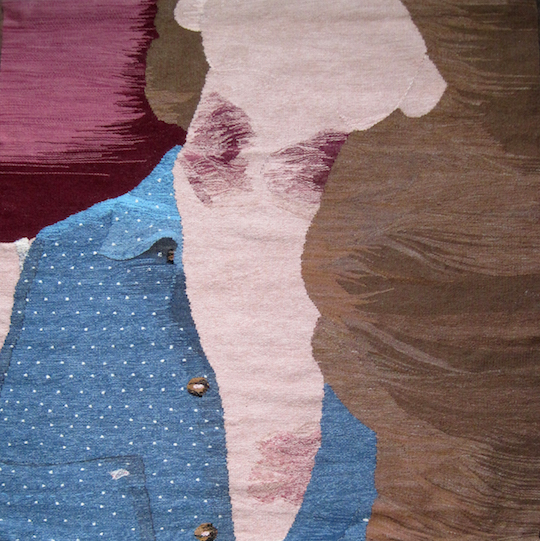
Erin M. Riley: Bruises
Can you recommend three or four books for textile artists?
- Zeros and Ones by Sadie Plant
- Sheila Hicks: Weaving as Metaphor by Nina Stritzler-Levine
- The Art of Modern Tapestry by Elizabeth Cumming, David Weir
- Tapestry: A Woven Narrative by Tom Howells, Timothy Wilcox, Caron Penney
What other resources do you use? Blogs, websites, magazines etc.
I use Instagram quite a bit to connect with other weavers, dyers and makers of all sorts from around the world. I appreciate the Textile Art Center’s new magazine project TAC, as well as Surface Design Journal, New American Painting, and Art in America.
What piece of equipment or tool could you not live without?
My loom! I weave nearly everyday and I feel lost when I am away from it!
Do you give talks or run workshops or classes? If so, where can readers find information about these?
I have done lectures at colleges or residencies, and I am eager to start teaching one-on-one workshops out of my Brooklyn studio on how to set up floor loom, weave structures, and tapestry. My contact info is on my website.
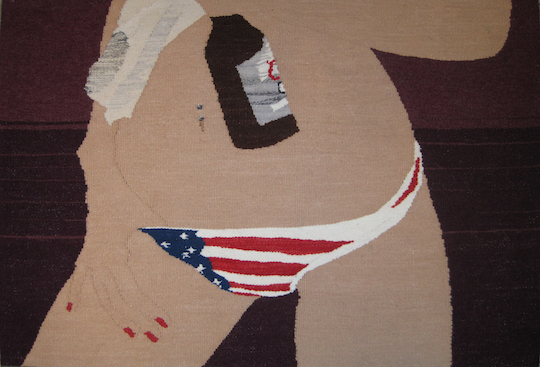
Erin M. Riley: Taste of the Rockies, 2011
How do you go about choosing where to show your work?
My process of exhibiting has evolved over the years. Working with galleries is much like dating; depending on how the relationship progresses, how work sells, how their clientele receive the work, the relationship might grow stronger or be quite short.
I have been quite wary of sending my work to galleries that have zero knowledge of exhibiting textiles, although it is very hard to avoid. I usually go with my gut and if I feel as though a gallery does not have my best intentions in mind, I generally move on.
Where can readers see your work this year?
I have three shows slated for 2015. In February I will be having a solo exhibition at Soze Gallery in Los Angeles, CA. In March I will be a part of a group show at Paradigm Gallery in Philadelphia, PA and in the summer I will be in a four person exhibition in Denmark at Galerie Wolfsen. All of the specific info can always be found on my website, and please join me on Instagram my name is erinmriley. I post mostly studio specific pictures, as well as exhibitions and weaving process.
To find out more about Erin please visit www.erinmriley.com.
Let us know what your favourite aspect of Erin’s work is by leaving a comment below.

















Inspiring!
Dear Erin –
Your particular combining of difficult images with the softness of textile is most affecting. “Undressing”, “History”, and “Mercedes” were particular favorites from these photos. Your remark about leaving your work at a point that makes it easier to begin again next day was a helpful reminder. Thank you for sharing your thoughts about your work in this interview.
I admire slow work. Erin’s dedication and hard work. Long hours and sticking to a theme to have a great collection for exhibition. Obviously Erin is totally passionate, brave and I wish her every success in her creative journey as a (textile) visual artist.
This was an inspiring read. It’s wonderful to see how weaving is being reinvigorated by artists like Erin.
I like the way Erin is combining a traditional technique, weaving, with contemporary images. Very interesting. I think she should just follow her work, don’t worry about not being sure what her niche is, most artists don’t!
I found this creative story very moving.
As women we experience not only our own lives but also are sensitised by those we care about and for.
The images reflect that. Thankyou Erin.